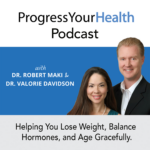
Our bodies make three different forms estrogens:
Estrone is usually considered an unhealthy estrogen. It is still bioidentical, but you do not want loads of estrone around when you are balancing the hormones. Estrone is common in young girls when they first get their periods and after menopause. Estrone metabolites can raise the risk for cancer. This is why you do not want a high level of estrone, which can also cause moodiness, feeling munchie, puffy and grumpy. With bioidentical hormone replacement therapy (BHRT), we do not use estrone for the above reasons mentioned.
Estradiol is the strongest of the three bioidentical estrogens. Estradiol is common in conventional hormone replacement in the form of oral, patches or transdermal. Premarin and Prempro are not estradiol and are not bioidentical. Because estradiol is the strongest of the estrogens, it has pros and cons to use.
Many women report gaining on average 6 to 8 lbs when taking conventional estradiol hormone replacement. It is primarily in the breasts and stomach.
So how do we get the positive benefits of estradiol without the negative side effects? The best way to properly balance estradiol is to take estriol with it.
Estriol is the gentlest form of estrogen. Some people refer to it as the weakest form, but I think that is a misnomer. When you combine estriol with estradiol you can get the beneficial effects of estradiol and estriol, without the negative side effects of estradiol.
Also, estriol is excellent for the skin and mucous membranes. Often, we use estriol for vaginal dryness during menopause. It is very beneficial for vaginal atrophy and pain with intercourse without any adverse effects. We also use it for wrinkles and skin integrity. Applying estriol topically can increase collagen and hydrate cells, which makes it especially great for reducing wrinkles.
Unfortunately, estriol is not available commercially. You are not going to get estriol hormone replacement from your primary care doctor or gynecologist. You are not going to get estriol from your big box pharmacy.
However, Functional Medicine doctors that specialize in bioidentical hormone replacement will be very familiar with estriol and estradiol. We use a combination of estriol and estradiol, which is known as Biest for hormone replacement. Biest and estriol are both available from compounding pharmacies. With compounding pharmacies, we can prescribe almost any dosing of Biest that we want based on the particular needs of the patient.
Hopefully, this has been informative and helpful to you. If you have any questions or personal stories, please feel free to email us at [email protected].
The post What is the Difference Between Estriol and Estradiol? | PYHP 036 appeared first on .
Discover the common and unfamiliar symptoms that you might be experiencing. Get access to cases of real women with hormonal conditions.

In this episode, we talk about hormone treatments for perimenopause and menopause. There is a vast distinction between perimenopause and menopause when it comes to treatment options. We often see women who are being treated for menopause when they are genuinely not in menopause. Meet Linda: Linda is a listener who sent us a question […]
Recently, Catherine posted a question on our website about Biest cream, and we knew this could interest our listeners. Biest is a combination of estriol and estradiol, one of the most common forms of estrogen therapy used in bio-identical hormone replacement. There are many doses, ratios, options, and methods of using Biest, so we thought […]
Welcome to the Progress Your Health Podcast! This is a podcast that helps you learn about balancing hormones, especially during perimenopause and menopause. We love hearing from our listeners. If you have a question, please visit our website and click Ask the Doctor a question. Let’s read Brigitte’s question! I have been listening and learning […]
In this episode, we talk about the difference between perimenopause and menopause. Both Dr. Maki and I (Dr. Davidson) have worked with women in perimenopause and menopause since 2004 and sometimes get a bit myopic and technical when it comes to explaining the differences. The other day, a patient of Dr Maki’s asked the question, […]
We recently got a great question from a listener and want to share it with you. This question is about a perimenopausal 51-year-old female. She is still menstruating and having confusion about her hormone testing and the hormone therapy that she is currently taking. She is experiencing some breast tenderness and irritability related to her […]
in this episode, we answered a listener’s question. We love questions from listeners. If you have a question, please visit our website and click Ask the Doctor a question. Here is the listener’s question: I have been perimenopause for at least 4 years now I am 47 and after completing a Dutch test with a […]